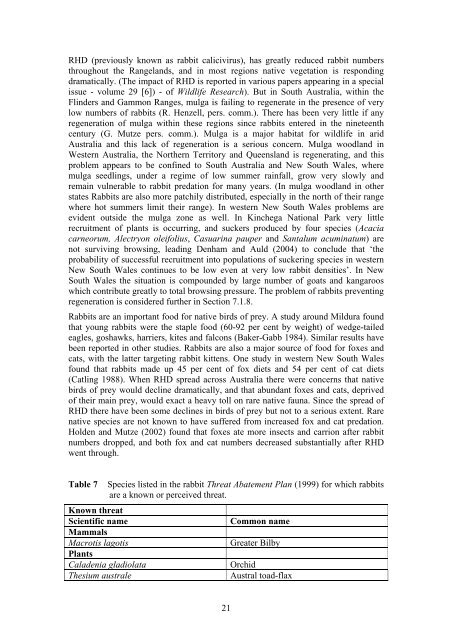Review of the management of feral animals and their impact on ...
Review of the management of feral animals and their impact on ...
Review of the management of feral animals and their impact on ...
Create successful ePaper yourself
Turn your PDF publications into a flip-book with our unique Google optimized e-Paper software.
RHD (previously known as rabbit calicivirus), has greatly reduced rabbit numbers<br />
throughout <str<strong>on</strong>g>the</str<strong>on</strong>g> Rangel<str<strong>on</strong>g>and</str<strong>on</strong>g>s, <str<strong>on</strong>g>and</str<strong>on</strong>g> in most regi<strong>on</strong>s native vegetati<strong>on</strong> is resp<strong>on</strong>ding<br />
dramatically. (The <str<strong>on</strong>g>impact</str<strong>on</strong>g> <str<strong>on</strong>g>of</str<strong>on</strong>g> RHD is reported in various papers appearing in a special<br />
issue - volume 29 [6]) - <str<strong>on</strong>g>of</str<strong>on</strong>g> Wildlife Research). But in South Australia, within <str<strong>on</strong>g>the</str<strong>on</strong>g><br />
Flinders <str<strong>on</strong>g>and</str<strong>on</strong>g> Gamm<strong>on</strong> Ranges, mulga is failing to regenerate in <str<strong>on</strong>g>the</str<strong>on</strong>g> presence <str<strong>on</strong>g>of</str<strong>on</strong>g> very<br />
low numbers <str<strong>on</strong>g>of</str<strong>on</strong>g> rabbits (R. Henzell, pers. comm.). There has been very little if any<br />
regenerati<strong>on</strong> <str<strong>on</strong>g>of</str<strong>on</strong>g> mulga within <str<strong>on</strong>g>the</str<strong>on</strong>g>se regi<strong>on</strong>s since rabbits entered in <str<strong>on</strong>g>the</str<strong>on</strong>g> nineteenth<br />
century (G. Mutze pers. comm.). Mulga is a major habitat for wildlife in arid<br />
Australia <str<strong>on</strong>g>and</str<strong>on</strong>g> this lack <str<strong>on</strong>g>of</str<strong>on</strong>g> regenerati<strong>on</strong> is a serious c<strong>on</strong>cern. Mulga woodl<str<strong>on</strong>g>and</str<strong>on</strong>g> in<br />
Western Australia, <str<strong>on</strong>g>the</str<strong>on</strong>g> Nor<str<strong>on</strong>g>the</str<strong>on</strong>g>rn Territory <str<strong>on</strong>g>and</str<strong>on</strong>g> Queensl<str<strong>on</strong>g>and</str<strong>on</strong>g> is regenerating, <str<strong>on</strong>g>and</str<strong>on</strong>g> this<br />
problem appears to be c<strong>on</strong>fined to South Australia <str<strong>on</strong>g>and</str<strong>on</strong>g> New South Wales, where<br />
mulga seedlings, under a regime <str<strong>on</strong>g>of</str<strong>on</strong>g> low summer rainfall, grow very slowly <str<strong>on</strong>g>and</str<strong>on</strong>g><br />
remain vulnerable to rabbit predati<strong>on</strong> for many years. (In mulga woodl<str<strong>on</strong>g>and</str<strong>on</strong>g> in o<str<strong>on</strong>g>the</str<strong>on</strong>g>r<br />
states Rabbits are also more patchily distributed, especially in <str<strong>on</strong>g>the</str<strong>on</strong>g> north <str<strong>on</strong>g>of</str<strong>on</strong>g> <str<strong>on</strong>g>the</str<strong>on</strong>g>ir range<br />
where hot summers limit <str<strong>on</strong>g>the</str<strong>on</strong>g>ir range). In western New South Wales problems are<br />
evident outside <str<strong>on</strong>g>the</str<strong>on</strong>g> mulga z<strong>on</strong>e as well. In Kinchega Nati<strong>on</strong>al Park very little<br />
recruitment <str<strong>on</strong>g>of</str<strong>on</strong>g> plants is occurring, <str<strong>on</strong>g>and</str<strong>on</strong>g> suckers produced by four species (Acacia<br />
carneorum, Alectry<strong>on</strong> oleifolius, Casuarina pauper <str<strong>on</strong>g>and</str<strong>on</strong>g> Santalum acuminatum) are<br />
not surviving browsing, leading Denham <str<strong>on</strong>g>and</str<strong>on</strong>g> Auld (2004) to c<strong>on</strong>clude that ‘<str<strong>on</strong>g>the</str<strong>on</strong>g><br />
probability <str<strong>on</strong>g>of</str<strong>on</strong>g> successful recruitment into populati<strong>on</strong>s <str<strong>on</strong>g>of</str<strong>on</strong>g> suckering species in western<br />
New South Wales c<strong>on</strong>tinues to be low even at very low rabbit densities’. In New<br />
South Wales <str<strong>on</strong>g>the</str<strong>on</strong>g> situati<strong>on</strong> is compounded by large number <str<strong>on</strong>g>of</str<strong>on</strong>g> goats <str<strong>on</strong>g>and</str<strong>on</strong>g> kangaroos<br />
which c<strong>on</strong>tribute greatly to total browsing pressure. The problem <str<strong>on</strong>g>of</str<strong>on</strong>g> rabbits preventing<br />
regenerati<strong>on</strong> is c<strong>on</strong>sidered fur<str<strong>on</strong>g>the</str<strong>on</strong>g>r in Secti<strong>on</strong> 7.1.8.<br />
Rabbits are an important food for native birds <str<strong>on</strong>g>of</str<strong>on</strong>g> prey. A study around Mildura found<br />
that young rabbits were <str<strong>on</strong>g>the</str<strong>on</strong>g> staple food (60-92 per cent by weight) <str<strong>on</strong>g>of</str<strong>on</strong>g> wedge-tailed<br />
eagles, goshawks, harriers, kites <str<strong>on</strong>g>and</str<strong>on</strong>g> falc<strong>on</strong>s (Baker-Gabb 1984). Similar results have<br />
been reported in o<str<strong>on</strong>g>the</str<strong>on</strong>g>r studies. Rabbits are also a major source <str<strong>on</strong>g>of</str<strong>on</strong>g> food for foxes <str<strong>on</strong>g>and</str<strong>on</strong>g><br />
cats, with <str<strong>on</strong>g>the</str<strong>on</strong>g> latter targeting rabbit kittens. One study in western New South Wales<br />
found that rabbits made up 45 per cent <str<strong>on</strong>g>of</str<strong>on</strong>g> fox diets <str<strong>on</strong>g>and</str<strong>on</strong>g> 54 per cent <str<strong>on</strong>g>of</str<strong>on</strong>g> cat diets<br />
(Catling 1988). When RHD spread across Australia <str<strong>on</strong>g>the</str<strong>on</strong>g>re were c<strong>on</strong>cerns that native<br />
birds <str<strong>on</strong>g>of</str<strong>on</strong>g> prey would decline dramatically, <str<strong>on</strong>g>and</str<strong>on</strong>g> that abundant foxes <str<strong>on</strong>g>and</str<strong>on</strong>g> cats, deprived<br />
<str<strong>on</strong>g>of</str<strong>on</strong>g> <str<strong>on</strong>g>the</str<strong>on</strong>g>ir main prey, would exact a heavy toll <strong>on</strong> rare native fauna. Since <str<strong>on</strong>g>the</str<strong>on</strong>g> spread <str<strong>on</strong>g>of</str<strong>on</strong>g><br />
RHD <str<strong>on</strong>g>the</str<strong>on</strong>g>re have been some declines in birds <str<strong>on</strong>g>of</str<strong>on</strong>g> prey but not to a serious extent. Rare<br />
native species are not known to have suffered from increased fox <str<strong>on</strong>g>and</str<strong>on</strong>g> cat predati<strong>on</strong>.<br />
Holden <str<strong>on</strong>g>and</str<strong>on</strong>g> Mutze (2002) found that foxes ate more insects <str<strong>on</strong>g>and</str<strong>on</strong>g> carri<strong>on</strong> after rabbit<br />
numbers dropped, <str<strong>on</strong>g>and</str<strong>on</strong>g> both fox <str<strong>on</strong>g>and</str<strong>on</strong>g> cat numbers decreased substantially after RHD<br />
went through.<br />
Table 7 Species listed in <str<strong>on</strong>g>the</str<strong>on</strong>g> rabbit Threat Abatement Plan (1999) for which rabbits<br />
are a known or perceived threat.<br />
Known threat<br />
Scientific name Comm<strong>on</strong> name<br />
Mammals<br />
Macrotis lagotis Greater Bilby<br />
Plants<br />
Caladenia gladiolata Orchid<br />
Thesium australe Austral toad-flax<br />
21
















